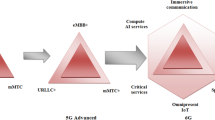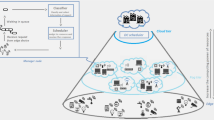Abstract
Self-organizing networking (SON) is an automation technology designed to make the planning, configuration, management, optimization and healing of mobile radio access networks simpler and faster. Most current self-organization networking functions apply rule-based recommended systems to control network resources which seem too complicated and time-consuming to design in practical conditions. This research proposes a cognitive cellular network empowered by an efficient self-organization networking approach which enables SON functions to separately learn and find the best configuration setting. An effective learning approach is proposed for the functions of the cognitive cellular network, which exhibits how the framework is mapped to SON functions. One of the main functions applied in this framework is mobility load balancing. In this paper, a novel Stochastic Learning Automata has been suggested as the load balancing function in which approximately the same quality level is provided for each subscriber. This framework can also be effectively extended to cloud-based systems, where adaptive approaches are needed due to unpredictability of total accessible resources, considering cooperative nature of cloud environments. The results demonstrate that the function of mobility robustness optimization not only learns to optimize HO performance, but also it learns how to distribute excess load throughout the network. The experimental results demonstrate that the proposed scheme minimizes the number of unsatisfied subscribers (Nus) by moving some of the edge users served by overloaded cells towards one or more adjacent target cells. This solution can also guarantee a more balanced network using cell load sharing approach in addition to increase cell throughput outperform the current schemes.








Similar content being viewed by others
References
Al-Hussaibi, W. A., & Falah H. A. (2019). Performance-complexity tradeoffs of MIMO-NOMA receivers towards green wireless networks. In 2019 IEEE 30th annual international symposium on personal, indoor and mobile radio communications (PIMRC) (pp. 1–6). IEEE.
Martyna, J. (2019). Optimal spectrum sharing in RF energy harvesting cognitive femtocell networks. In International conference on computer networks (pp. 220–232). Cham: Springer.
Silva, K. D. C., Becvar, Z., & Frances, C. R. L. (2018). Adaptive hysteresis margin based on fuzzy logic for handover in mobile networks with dense small cells. IEEE Access, 6, 17178–17189.
Hegazy, R. D., Nasr, O. A., & Kamal, H. A. (2018). Optimization of user behavior based handover using fuzzy Q-learning for LTE networks. Wireless Networks, 24(2), 481–495.
Vijayarani, R., & Nithyanandan, L. (2017). Dynamic cooperative base station selection scheme for downlink CoMP in LTE-advanced networks. Wireless Personal Communications, 92(2), 667–679.
Nguyen, M. T., Sungoh, K., & Hongsoog, K. (2017). Mobility robustness optimization for handover failure reduction in LTE small-cell networks. IEEE Transactions on Vehicular Technology, 67(5), 4672–4676.
Zhang, J., Zhao, Y., & Ma, X. (2020). Reliability modeling methods for load-sharing k-out-of-n system subject to discrete external load. Reliability Engineering & System Safety, 193, 106603.
Ma, Bo, Yang, Bowei, Zhu, Yunpeng, & Zhang, Jie. (2020). Context-aware proactive 5G load balancing and optimization for urban areas. IEEE Access, 8, 8405–8417.
Mohajer, A., Barari, M., & Zarrabi, H. (2017). Big data based self-optimization networking: A novel approach beyond cognition. Intelligent Automation & Soft Computing, 23, 1–7.
Nikjoo, F., Mirzaei, A., & Mohajer, A. (2018). A novel approach to efficient resource allocation in NOMA heterogeneous networks: Multi-criteria green resource management. Applied Artificial Intelligence, 32(7–8), 583–612.
Phan, N. Q., Bui, T. O., Jiang, H., Li, P., Pan, Z., & Liu, Nan. (2017). Coverage optimization of LTE networks based on antenna tilt adjusting considering network load. China Communications, 14(5), 48–58.
Marinescu, A., Jiang, Z., Zhou, S., Da Silva, L. A., & Niu. Z. (2019). Deep learning–based coverage and capacity optimization. In Machine Learning for Future Wireless Communications, (pp. 63–83).
Sanchez, A., Arauz, J., McClure, J. W., & Miller, Z. (2016). Cooperative self-organized optimal power control for interference mitigation in femtocell networks. In 2016 IEEE Colombian conference on communications and computing (COLCOM) (pp. 1–6). IEEE.
Tiwana, M. I. (2014). Self-organizing networks: A reinforcement learning approach for self-optimization of LTE mobility parameters. automatika, 55(4), 504–513.
Daher, T., Jemaa, S. B., & Decreusefond, L. (2017). Q-learning for policy based SON management in wireless access networks. In 2017 IFIP/IEEE symposium on integrated network and service management (IM) (pp. 1091–1096). IEEE.
Neapolitan, R. E., & Jiang, X. (2018). Artificial intelligence: With an introduction to machine learning. Boca Raton: Chapman and Hall.
Mutua, J., Nyakoe, G. N., & Oduol, Vitalice K. (2017). CPICH power control for 3G cellular networks for cell capacity improvement based on fuzzy logic control. Journal of Sustainable Research in Engineering, 3(2), 37–46.
Claussen, H., Ho, l. T. W., & Samuel, L. G. (2017). Controlling uplink power for picocell communications within a macrocell.” U.S. Patent 9,629,096, issued April 18, 2017.
Murudkar, C. V., & Gitlin, R. D. (2019). User-centric approaches for next-generation self-organizing wireless communication networks using machine learning. In 2019 IEEE international conference on microwaves, antennas, communications and electronic systems (COMCAS) (pp. 1–6). IEEE.
Shah, B., Dalwadi, G., Pandey, A., Shah, H., & Kothari, Nikhil. (2020). Online CQI-based optimization using k-means and machine learning approach under sparse system knowledge. International Journal of Communication Systems, 33(3), e4200.
Kakadia, D., & Ramirez-Marquez, J. E. (2020). Quantitative approaches for optimization of user experience based on network resilience for wireless service provider networks. Reliability Engineering & System Safety, 193, 106606.
Farzi, S., Yousefi, S., Bagherzadeh, J., & Eslamnour, B. (2019). Zone-based load balancing in two-tier heterogeneous cellular networks: a game theoretic approach. Telecommunication Systems, 70(1), 105–121.
Tam, H. H. M., Tuan, H. D., Ngo, D. T., Duong, T. Q., & Poor, H. V. (2016). Joint load balancing and interference management for small-cell heterogeneous networks with limited backhaul capacity. IEEE Transactions on Wireless Communications, 16(2), 872–884.
Jouini, H., Escheikh, M., Barkaoui, K., & Ezzedine, T. (2017). Mobility load balancing over intra-frequency heterogeneous networks using handover adaptation. In International conference on verification and evaluation of computer and communication systems (pp. 108–123). Cham: Springer.
Hoseinitabatabei, S. A., Mohamed, A., Hassanpour, & M., Tafazolli. R. (2020). The power of mobility prediction in reducing idle-state signalling in cellular systems: A revisit to 4G mobility management. IEEE Transactions on Wireless Communications, 19(5), 3346–3360.
Zakaria, E., Awamry, A. A., Taman, A., & Zekry, A. (2018). A novel vertical handover algorithm based on adaptive neuro-fuzzy inference system (ANFIS). International Journal of Engineering & Technology, 7(1), 74–78.
Fedrizzi, R., Goratti, L., Rasheed, T., & Kandeepan, S. (2016). A heuristic approach to mobility robustness in 4G LTE public safety networks. In 2016 IEEE wireless communications and networking conference (pp. 1–6). IEEE.
Mohajer, A., Mojtaba M., Niasar, F. A., Ghadikolayi, A. A., & Nabipour. M. (2013). Network coding-based QoS and security for dynamic interference-limited networks. In International conference on computer networks (pp. 277–289). Berlin: Springer.
Mohajer, A., Barari, M., & Zarrabi, H. (2016). QoSCM: QoS-aware coded multicast approach for wireless networks. TIIS, 10(12), 5191–5211.
Gijón, C., Toril, M., Luna-Ramírez, S., & Marí-Altozano, M. L. (2019). A data-driven traffic steering algorithm for optimizing user experience in multi-tier LTE networks. IEEE Transactions on Vehicular Technology, 68(10), 9414–9424.
Anannya, M., & Shourov, R. M. (2018). Performance measurement model of mobile user connectivity in femtocell/macrocell networks using fractional frequency Re-use scheme. International Journal of Advanced Computer Science and Applications, 9(5), 355–362.
Liu, L., & Hodgins, J. (2017). Learning to schedule control fragments for physics-based characters using deep q-learning. ACM Transactions on Graphics (TOG), 36(3), 1–14.
Tong, Y., & Tien, I. (2019). Analytical probability propagation method for reliability analysis of general complex networks. Reliability Engineering & System Safety, 189, 21–30.
Lobinger, A., Stefanski, S., Jansen, T., & Balan, I. (2010). Load balancing in downlink LTE self-optimizing networks. In 2010 IEEE 71st vehicular technology conference (pp. 1–5). IEEE.
Shayea, I., Ismail, M., Nordin, R., Mohamad, H., Abd Rahman, T., & Abdullah, N. R. (2016). Novel handover optimization with a coordinated contiguous carrier aggregation deployment scenario in LTE-advanced systems. Mobile Information Systems, 16, 1–20.
Tuncel, N. O., & Koca, M. (2015). Joint mobility load balancing and inter-cell interference coordination for self-organizing OFDMA networks. In 2015 IEEE 81st vehicular technology conference (VTC Spring) (pp. 1–5). IEEE.
Necker, M. C., Gauger, C. M., Kiesel, S., & Reiser. U. (2006). Ikremulib: A library for seamless integration of simulation and emulation. In 13th GI/ITG conference-measuring, modelling and evaluation of computer and communication systems (pp. 1–18). VDE.
Author information
Authors and Affiliations
Corresponding author
Additional information
Publisher's Note
Springer Nature remains neutral with regard to jurisdictional claims in published maps and institutional affiliations.
Rights and permissions
About this article
Cite this article
Mohajer, A., Bavaghar, M. & Farrokhi, H. Reliability and Mobility Load Balancing in Next Generation Self-organized Networks: Using Stochastic Learning Automata. Wireless Pers Commun 114, 2389–2415 (2020). https://doi.org/10.1007/s11277-020-07481-1
Published:
Issue Date:
DOI: https://doi.org/10.1007/s11277-020-07481-1




